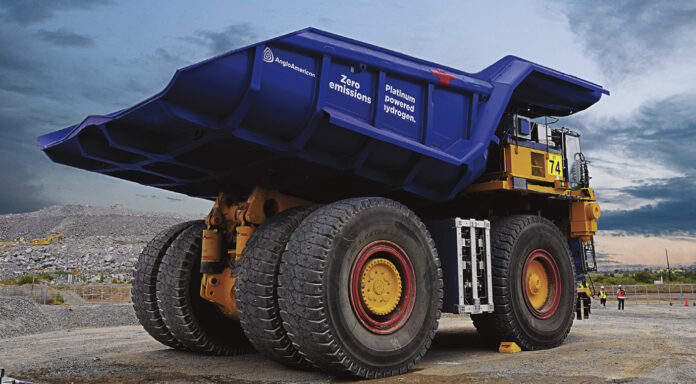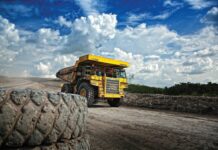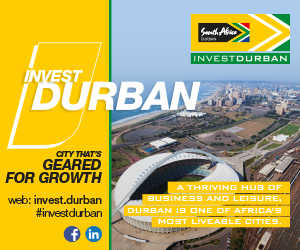
Talk about clean energy via green hydrogen has been going on for some years all around the world, but suddenly that talk has turned into serious dialogue between national governments and powerful business interests who really want to do something concrete about creating power in a cleaner, more sustainable way.
In May 2022, talk became action at the Mogalakwena platinum group metals (PGMs) mine in Limpopo when Anglo American unveiled “a prototype of the world’s largest hydrogen-powered mine haul truck designed to operate in everyday mining conditions at its Mogalakwena PGMs mine in South Africa”.
Hydrogen is generated via the electrolysis of water using electricity. If renewable energy is deployed to make the electricity that makes the hydrogen, then that is “green hydrogen”. Hydrogen has a wide range of uses across multiple sectors, from transport to heat generation and power.
Anglo American intends using green hydrogen which it will produce at the mine to feed into its green-hydrogen system, which includes production, fuelling and a haulage system.
The Mogalakwena mine is near Mokopane (formerly Potgietersrus) and south-west of Polokwane, the provincial capital of Limpopo Province.
The 2MW hydrogen-battery hybrid truck generates more power than its diesel predecessor and can carry a 290-ton payload. Forty Anglo trucks will be retrofitted, starting in 2024, and the whole fleet should be green by 2030.
The operating company of the Musina-Makhado Special Economic Zone (MMSEZ) has signed a partnership agreement for green-hydrogen electricity generation with Australian company African Resources Development Energy (ARD Energy). Paladin Hydrogen, a partner of ARD Energy, is using its Tasmanian project as the prototype of coal-to-hydrogen technology that apparently has zero emissions. Once that project reaches sufficient scale, the intention is to deploy the technology to the Makhado coal fields of northern Limpopo.
The Fetakgomo-Tubatse Special Economic Zone (FTSEZ), on the other hand, has plans to turn that area’s platinum group metals to good effect in the energy field. Platinum and iridium are important catalysts in the process which creates hydrogen, so that has become one of the big selling points of the FTSEZ. In July 2022, a delegation from the FTSEZ participated in the UK-RSA partnership mission on Hydrogen Economy Roadmap.
Anglo Platinum’s 75MW solar plant under construction at Mogalakwena could well become the 320MW plant that the company wants it to be, if President Ramaphosa announces the lifting of restrictions on the scale of private generation. He surprised and pleased the business community in 2021 when he lifted the limit on the size of private projects that did not need to apply for licences to 100MW; it’s very likely more red tape will fall away as South Africa’s utility, Eskom, continues to fail to keep the lights on.
With ample wind and sun, a long coastline and 75% of the world’s PGMs, Limpopo and South Africa are well placed to be leaders in the production of green hydrogen.
Hydrogen Valley
The Limpopo Province is one of the three hubs on which a Hydrogen Valley is planned to stretch from the metals-rich Bushveld area through the country’s industrial and commercial heartland to two of the continent’s busiest ports in Richards Bay and Durban.
It is envisaged as a means of kickstarting the hydrogen industry in South Africa. The other two hubs are Johannesburg and Richards Bay. Demand at the Limpopo end of the corridor will be driven by trucks used in the mining industry and along the busy N1 highway. Current users of hydrogen in the Johannesburg area will be expected to switch to green hydrogen and green hydrogen will also be used as feedstock substitution for ethylene production and fuel and as a catalyst for iron and steel, in public buildings and buses. Future private-building demand is expected to grow. At Richards Bay Port there is potential to export green hydrogen and use it as a fuel for port functions. Trucks using the N3 could be another market.
The Hydrogen Valley concept is being researched and developed by a collaboration that includes the Department of Science and Innovation (DSI), the South African National Energy Development Institute (SANEDI), Anglo American, Bambili Energy and ENGIE. A 2021 feasibility report suggests that $4-billion could be added to South Africa’s GDP if the valley were successfully implemented, with an additional tax revenue of about $900-million.
The Department of Science and Innovation has a chief director of hydrogen and energy. The Industrial Development Corporation is mandated by national government to champion the commercialisation of the green hydrogen economy. A hydrogen strategy was compiled for the country as far back as 2008, the National Hydrogen and Fuel Cell Technologies Research, Development and Innovation strategy.
As of 2022, the IDC has invested R15.4-billion in renewable energy in four provinces: 25 projects with a combined capacity of 899.2MW.
Entrepreneur Mashudu Ramano wants his Mitochondria Energy Company to produce 250MW in hydrogen fuel cells per year from 2023. He has found a commercial partner in AVL, an Austrian engineering company, and financial backing from the Industrial Development Corporation and the Development Bank of Southern Africa (DBSA). He wants to operate in Mpumalanga where coal plants will be shutting down in rapid succession over the next few years and where he believes there is sufficient water for the project. Chris Barron ran an extensive interview with Ramano in his “Newsmaker” column in the Sunday Times in April 2021. Ramano says that the South Africa’s export potential in green hydrogen is R1.5-trillion “more than half our GDP”.







